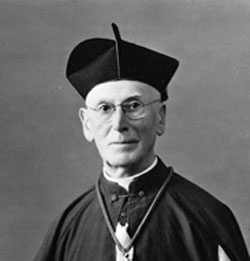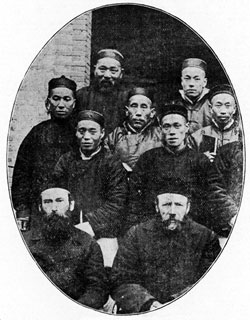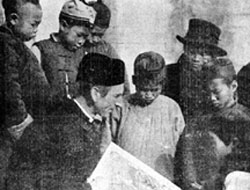Pillar of the Kingdom
The memoirs of Monsignor John Mary Fraser, founder of Scarboro Missions.
By January/February 2002
Return to Table of Contents
Print Article
I was born in a cottage, number 19 Clinton Street, Toronto, built by my father. My younger brother Charlie and I slept in the same room. There was a stove in the central room but no heat in ours...Mother would heat a blanket and wrap it around our feet. She was very thrifty, and had to be to feed her large family. Father was earning only twenty cents an hour...how they ever managed to get along I do not know. Things were cheaper then, it is true, but even then, bread was six cents a loaf, milk six cents a quart, and meat ten cents a pound. Mother made our clothes and knitted our stockings and mitts...
Our house was on the outskirts of the city. West of our place there were no houses, only vacant fields, hills and woods...We thought it a great convenience when street-cars, drawn by horses, came as far as Bathurst Street, six blocks from where we lived...
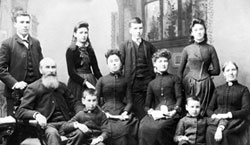 Fraser family portrait, 1889. Monsignor Fraser is seated beside his father (front, left). His parents were born in Scotland. Married in 1865, they had eleven children, six were born in Scotland and five were born in Canada.
Fraser family portrait, 1889. Monsignor Fraser is seated beside his father (front, left). His parents were born in Scotland. Married in 1865, they had eleven children, six were born in Scotland and five were born in Canada.
I was blessed with good parents and good brothers and sisters...No member of the family would think of missing Mass on Sunday, although the church was far away and the weather anything but good on some days...
I had always wished to be a priest, but father could not afford to send me to college. One evening, when I was 14, I was serving censer bearer at vespers and went into the adjoining chapel to light the charcoal. It was dark. Father Cruise, the curate, was kneeling there praying. I had never spoken to him before. Without introduction he said: "Would you like to be a priest?" I said: "Yes!"...I was overjoyed and raced home to tell them the good news. I was to be a priest!
Father Cruise saved my vocation; only for him I might never have been a priest. He undertook to pay my tuition fees at St. Michael's College...
For a year and a half I had taken private lessons in Latin from Father Cruise so that on entrance to St. Michael's College I was able to skip the first year of the classical course...The College was far, a mile and a half away. I went home for my noon meal, which meant I walked four times that distance every day. This exercise served me well in China where I often had to walk 20 to 30 miles in a day...
Toronto had no seminary at the time. Aspirants to the priesthood were sent to the Grand Seminary in Montreal or to Collegio Brignole Sale, in Genoa, Italy. Archbishop Walsh sent me to Genoa. It was September 1896. I was 19 at the time and travelled alone...A desire to go to China
During the first few years in Genoa I had no intention other than of returning to Toronto after ordination. But, after studying in Brignole Sale, a foreign mission seminary, and having read while there the lives of Blessed Perboyre and Blessed Clet, both of whom laboured in China, I felt a desire to go to that country... For six months, without saying a word to anyone, I pondered the weighty decision of severing connections with Toronto Archdiocese...I obtained due permission from Archbishop O'Connor and was ordained as a subject of the Sacred Congregation of Propaganda Fide...
Father Asinelli, a missionary from Ningpo, Chekiang Province, China, paid us a visit. His stories strengthened my vocation for China. He taught me the Hail Mary in Chinese and invited me to go to his part of China, promising to accompany me there.
I was ordained a priest on July 14, 1901, by Archbishop Reggio, in the chapel of his palace in Genoa...I had intended to go directly to China without going home to Canada, when I learned that Father Asinelli had already left. It seems he received sudden orders. A departing missionary took sick and he had to take his place...
I paid a visit to the cardinal-prefect of Propaganda in Rome and said I desired to go to China.
"A missionary must go where he is sent," he said.
"I know," I said, "and I am ready to go anywhere-to Alaska if need be; but a missionary may manifest a desire to go to a particular mission."
"Well, where are you going now?"
"To Canada, to visit my parents."
"Bon viaggio! Good-bye!" he said and the interview was ended...
During the 14 months I spent in Toronto...I spent six months in my home parish of St. Mary's and enjoyed the work very much...
Into the great unknown
It was a sad parting at Union Station, Toronto, for the family and the few friends who were there. I was going alone into the great unknown-to the mysterious land of China, to tackle an outlandish language and to meet with I did not know what fate. The anti-foreign Boxer uprising, in which many persons were martyred, had barely been quelled. I did not expect to last more than a year.
"China is home to one-sixth of the world's peoples, and it is the reason for our existence as Scarboro Missions. We were founded early in the 20th century exclusively for mission in china. I was quite conscious of this as I travelled through Beijing, Guiyang, Shenzhen and Hong Kong. It is sacred ground for us"
At Vancouver I was disappointed at seeing my ship, the Athenian. It looked so small, too small to cross the great Pacific. There were few passengers on board. An American and I were the only ones travelling first class...
One day he called to me: "Have you ever seen a storm?"
I answered, "I have seen nothing else since I came on board this ship."
"Look outside," he said.
The waves were mountain high. The air was filled with spray. The sky had turned pink. The wind was howling and blowing heavy steel cables into curves as if they were clotheslines. We had run into a typhoon...
The captain remained on the bridge for 48 hours. When he came down we asked him how fast the wind was blowing. He said it could not blow faster and that when he arrived in China he was going to have the name of that ocean changed to Terrific instead of Pacific...
The captain announced one evening that we would see a lighthouse, the first lighthouse of Japan...As I had no Mass kit, I had been deprived of celebrating the Holy Sacrifice for 20 days. I resolved to leave the ship at Yokohama, cross Japan by train, and stop at different places to say Mass. That would cost me $20 extra but it was worth it. I could catch the same ship again at Nagasaki...
In Japan, I did not like to see men pulling rickshaws; it seemed to me to be too humiliating-treating men like horses. I was soon rid of that idea. In the afternoon, having to go to a certain station and not knowing the way, I was surrounded by a crowd of rickshaw men, all eager for the job. I thought, well, if you are so anxious to pull me, why should I object? And jumped in...
I said Mass in Yokohama and in Kobe and then caught the train for Nagasaki. Little did I think that I would be building a church in Nagasaki 50 years hence!
After a few days, my ship came to port. I embarked and crossed the Yellow Sea to Shanghai...
I had telegraphed the time of my arrival and Father Asinelli came from Ningpo, an overnight journey, to receive me...it was December 18, 1902...
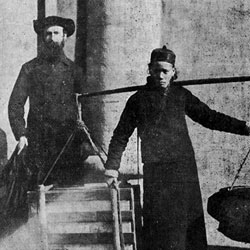 Fr. Fraser setting out on a journey through Fenghwa county. Circa 1903. He spent his first eight years in China stationed in the large church in the city of Ningpo and serving the rural district of Fenghwa, 30 miles to the south. Fenghwa district was about 500 square miles.
Fr. Fraser setting out on a journey through Fenghwa county. Circa 1903. He spent his first eight years in China stationed in the large church in the city of Ningpo and serving the rural district of Fenghwa, 30 miles to the south. Fenghwa district was about 500 square miles.
December 1902 – Arrival in Ningpo
We left by coastal steamer and arrived next morning, December 21, 1902, in Ningpo, at the wharf in front of the cathedral. Bishop Reynaud gave me a hearty welcome and I said Mass. He called a tailor to fit me out with soutane and clerical overcoat, at his expense...
One day a priest came from the minor seminary of Chusan with the welcome news that the boys knew Latin well...if I could only go there, I thought, I could soon learn Chinese. I requested the bishop to let me go...
The five months I spent there gave me a foundation in the language...
The vicar-general of Ningpo, Father Faveau, recalled me from Chusan saying that I knew Chinese well enough to do missionary work. I was stationed in the big church in the middle of Ningpo where for eight years I acted as curate. At the same time, I took care of the district of Fenghwa, 30 miles to the south...
Getting to know the Chinese Christians
The Chinese Christians always put up a good meal for the missionary although they themselves, the whole year round, eat little more than rice and vegetables. When visitors come and especially when the long-looked-for priest arrives, they manage to have fish, eggs and meat. They send word from one place to another that the priest is coming so all is in readiness to receive him...
The Chinese Christians are very polite and do not deem themselves worthy to sit down to table with the missionary. They call him Spiritual Father and refer to themselves as Sinners...When the missionary visits a family of Christians, or catechumens, or when they come to see him, they get down on both knees and make a profound bow, a sign of their filial respect...
Ningpo, where I live, is a large city and very populous. It was said to contain from three to four hundred thousand inhabitants...They are nearly all pagan and do not seem much inclined to become Catholic on account of their minds being engrossed with business and worldly matters...
The country folk are more disposed to receive the light of faith and eternal salvation. For that reason the greater number of our converts in Chekiang Province are among the farmers. As for the people of large cities, the rich and powerful, we are making very little headway among them...The greatest obstacle of all for them is that they are servants of the emperor, and wish to follow him in everything, for fear of being dismissed...
"It would take volumes to fell all of my experiences in the different mission, fields I cultivated-Ningpo, Fenchwa, Taichowfu, Lishui and Kinhwa. In each place I had to learn a new dialect."
When I go to a new place, all the people are curious to see me. I take advantage of their curiosity to tell them the good news of God, the Creator of heaven and earth...
There are many temples in China. Every village has two or three, every town quite a few, and in the large cities they are innumerable. In the wayside tea houses there is always found an altar with an idol upon it, and before it a stone step upon which to kneel and adore; but not many do. The Chinese, especially the men, are losing all faith in their idols...
Nearly opposite our house in Ningpo is the House of Mercy kept by the Sisters of Charity of St. Vincent de Paul. There are 400 inmates in their establishment...Two hundred are little girls who, when small, were given by their parents to the Sisters. The Chinese are very poor, and in many cases cannot afford to bring up a girl...The girls, you know, do not go to school, unless they are Christians...
Other departments of the Sisters' establishment are a free hospital for women, Christian or pagan; a workshop in which the finest fancy work is done; a home for old women, whether Christian or pagan, and a school for girls, boarders and day-scholars...
Visiting remote towns and villages
One evening I arrived at a town of about 2,000 families. I cannot describe the commotion of the people upon my arrival. All had heard of the Europeans, but very few had seen them, and fewer still had seen a priest in ecclesiastical dress. There was a rush from all sides to see me. The word passed like wildfire throughout the whole town, and everyone made it a point to come and have a look. The Catholic Church has a great name in China; it is known far and wide. That is another reason why they came; I was the first representative of the world-wide Church to appear in their midst...
Of course, as you may well imagine, I have long since lost all sense of bashfulness at being looked at...It has been my experience that these simple people never laugh at foreigners or make unkind remarks about them...
All the time I was in China I was never actually attacked by robbers although I came near to it several times...
It would take volumes to tell all of my experiences in the different mission fields I cultivated, Ningpo, Fenghwa, Taichowfu, Lishui and Kinhwa. In each place I had to learn a new dialect...
Missionaries and funds needed
After building the Sacred Heart church, rectory, and school house in Fenghwa city, and opening chapels here and there in the country, each with a catechist and group of converts, I needed funds to develop the work. I also realized that many more missionaries would be needed if we hoped to convert China. I decided to go to America with a double object in view, to collect funds and to found, if possible, a seminary for the training of missionaries.
I arrived in New York in December 1910 and received great encouragement from Cardinal Farley who thought my plan for foreign mission seminaries very practical. I proposed that the United States be divided into spheres-that in New York, for instance, there be a seminary for China; in Boston one for Japan; in Chicago one for India or Africa, and so on. I reckoned that by this means, more fruit would be obtained for the foreign missions than if one national seminary for all missions was established. Besides, it would be more practical from the point of view of language study.
In the seminary I proposed for New York, the students would study Chinese from the very beginning of their classical course...By the time they finished their course and were ready to go to China, they would already know the language and not be like babbling little children... In April 1911 Cardinal Farley made the decision. The meeting of the archbishops took place in Washington. Father Walsh was given authority to found a national seminary for the foreign missions in general...I said I understood his position and was glad a foreign mission seminary was to be established and this would leave me free to go elsewhere, for instance to Canada, to found a seminary for China...
Next day I was sailing on the famous Lusitania for Rome via London. I gave the Sacred Congregation of Propaganda the first news about the new foundation in the United States. I begged them to see to it that the missionaries trained therein would actually be sent to pagan countries, for there was a rumour that they would be sent to the Philippines. They promised that that would be stipulated.
I asked the Sacred Congregation to give me a letter to the bishops of Canada requesting them to permit me to establish a seminary there for China...
I traversed Ireland, preaching in the cathedrals and churches on China, its vast pagan population, and its need for priests...They had never before seen or heard a missionary from China...
I published a work on the Chinese missions entitled "Unknown China", and had 10,000 copies printed and placed in the pamphlet racks at the doors of churches. But my principal object was to establish a seminary for China. I brought up the question at the meeting of the bishops at Maynooth. The proposition was favourably received...Cardinal Logue, who was at the meeting, offered me a house and 25 acres of land in Monesterboice in County Kildare as a source of revenue for the proposed China Mission Seminary...
On reaching the United States in October 1911, I began a five months' campaign for funds in all the big cities of the Eastern States from Boston to Baltimore...
By February 1912, having amassed the sum of $12,000, I decided to return to China. For the last two weeks I obtained permission from the bishop of Brooklyn to collect in his diocese. I went to a likely parish with Bishop Macdonald's letter, but the priest said he could not give me a collection, but that in the next parish I ought to get one. It was near dinnertime. He looked at the clock and said, "If you hurry, you will get the pastor in before he goes to dinner."
...This good old Irish priest, after hearing my appeal, said, "Well, Father, first of all let us take dinner." During the meal I spoke a great deal about China. Father Galvin, one of the curates, was sitting opposite me, silent, but taking it all in. The first curate said, "There's your man!" pointing to Father Galvin.
On leaving the dining room the latter whispered, "Come to see me after you get through with the pastor!" Sensing that he might propose going to China, I enquired of the pastor as to his character.
"He is a very energetic man," he replied. That was recommendation enough for me. Father Galvin and I talked over everything. He invited me to come to see him in a week's time...
During the week, he made up his mind; he would go to China. "In that case," I said, "you will have to hurry, as I am leaving within a fortnight. I have already booked my passage to China." He wrote to Cork and received permission from his bishop in time for us to go to Toronto together. We left there on March 1, 1912, for Vancouver, where we embarked on an Empress liner...
In mid-ocean I related to Father Galvin the work I had done in Ireland.
"And why did you not stay there and continue it?" he asked.
"That's for you to do. You are an Irishman and can do it better."
"But I am going to China, not to Ireland, now."
"You are going in the right direction," I said. "You would need to be a few years in China as a missionary before you could undertake the work." He remained silent, thoughtful.
During the four years he spent in Hangchow Diocese he wrote to me several times urging me to go to Ireland to continue the work and I would answer: "You are an Irishman. It is for you to go!"
In 1916 we met in Shanghai. After a long conversation in which I gave him all the reasons why he should undertake the work of founding a seminary in Ireland for China, he said: "Well, I guess I must go."
...He founded the Society of Saint Colomban and in 1920 returned to China with the first band of 17 missionaries and later became their bishop...
Feeding the hungry
From Shanghai I went on to Shaohing where my bishop, Bishop Reynaud, was distributing food to a starving population...I gave him $1,000 for the orphans. He had spent the last cent to buy cloth to cover 20 naked infants left at his door. I gave him another thousand to buy food for 4,000 famine-stricken people clamouring at our door. On accepting my gift he said, "This is an apparition of Providence!"
The next day 50,000 people congregated, seeking the bishop's help. I gave him $5,000 more which he promised to refund to me if favourable answers came from Cardinal Farley and Bishop O'Donnell from Brooklyn; I had sent cablegrams to them asking their help...
Now they both answered generously to my cablegrams, each sending $5,000 for the famine-stricken. The situation was saved and the people of Shaohing erected a monument in honour of Bishop Reynaud.
The bishop told me he was not sending me back to Fenghwa but was giving me a new parish-a bigger parish-Taichowfu...
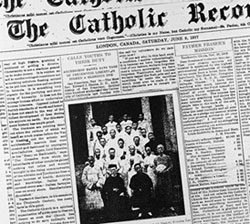 Through The Catholic Record of London, Ontario, which published Fr. Fraser's letters and photos,
Canadians came to know of his work in China.
Through The Catholic Record of London, Ontario, which published Fr. Fraser's letters and photos,
Canadians came to know of his work in China.
My best benefactor during my stay in Taichowfu was The Catholic Record of London, Ontario. The editor, Dr. G.T. Foley, published my letters and pictures...Through The Catholic Record, with its 30,000 subscribers scattered throughout Canada, Canadians came to know of my work in China and the task of founding the Scarboro Foreign Mission Society was facilitated...
By 1917, after six years of work in Taichowfu...I resolved to go to Canada to found a seminary to train missionaries for China...
In February 1918 I set out for Hong Kong...Before leaving Canton and Hong Kong I obtained nice letters of recommendation from Bishops De Guebriant and Pozzini urging the bishops of Canada to approve of the seminary.
Just before leaving I met a Spanish priest who was trying to learn English from a dictionary. He wanted to be able to preach in the Cathedral of Hong Kong. I told him the only way to learn English was to go to an English-speaking country, that I was going to Canada and, if he wished, he could live at the seminary I intended to found...He arrived a month later, entered St. Michael's College, and afterwards our Almonte College. He remained two years, helping out principally at St. Mary's Church, Almonte. He then went to Spain in an endeavour to found a Spanish China Mission College, the same as ours but independent from it. He was instrumental in inducing the Archbishop of Burgos to found the present Foreign Mission Seminary of Burgos, Spain...
In Toronto I told Archbishop MacNeil that I wanted to found a seminary for China. He threw up his hands, "Impossible! The English-speaking Catholic people of Canada are too few and scattered. They could not finance such a work. You ought to go to Quebec. They have the men and the means to do such a work."
...Next day I was in Montreal interviewing Archbishop Bruchesi. His Grace took sympathetically to the proposal...At my next interview he told me he had considered the question before God and with his priests at retreat, and decided to found a foreign mission seminary...All of the bishops of Quebec got together and the next year founded the Foreign Mission of Pont-Viau, suburb of Montreal.
The next place to try was Antigonish, Nova Scotia...The bishop could not decide immediately, he said, but would consult his priests at retreat next year in July. Next year! That was a long time to wait...
Rousing a missionary spirit in Canada
I continued my campaign of preaching in the churches and lecturing in the seminaries, colleges, and schools, trying to rouse a missionary spirit among the clergy and people and foster vocations for the missionary life. While visiting Ironside College with this intent, a phone call from Father Cavanagh of Almonte, Ontario, in the Archdiocese of Ottawa, invited me to pay him a visit...I did visit him in Almonte and told him the object of my campaign. "But," I said, "I need a place in which to begin my work."
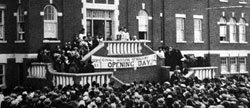 Left: The opening and blessing of St. Francis Xavier China Mission Seminary (now known as Scarboro Missions), 2685 Kingston Road, Scarborough, Ontario, Canada. September 21, 1924. Since its founding in 1918, the seminary outgrew two previous locations and remains here to this day.
Left: The opening and blessing of St. Francis Xavier China Mission Seminary (now known as Scarboro Missions), 2685 Kingston Road, Scarborough, Ontario, Canada. September 21, 1924. Since its founding in 1918, the seminary outgrew two previous locations and remains here to this day.
"How would you like this house?" he asked.
"Well, but I must first get permission from the Archbishop of Ottawa."
"We'll get that, too," he said.
"How much do you want for the house?" I asked.
"Just what we paid for it, $5,000."
...It was the end of October 1918. Archbishop Gauthier of Ottawa was away at the time, ill in a sanatorium in Detroit. On November 1, All Saints Day, the Sisters of St. Joseph and I began a novena to St. Joseph to obtain the desired permission. During the novena His Grace returned to Ottawa and Father Cavanagh went to see him.
"Be sure to let me know by phone if the archbishop gives permission," I said in parting. In the afternoon he phoned. The archbishop had given permission to start the college...
"Tell Father Fraser," he had said, "to go ahead and found the college for China. I have seen the consultors and they all approve."
China Mission College founded in 1918
It was November 9, 1918, (the ninth day of the novena), and the day we celebrate as Foundation Day...
I continued my campaign for vocations and funds. Now and then I returned to Almonte to give directions and answer correspondence.
I had sent a circular letter to all the English-speaking priests of Canada telling them that I now had a headquarters and that the China Mission College had been founded in Almonte...
By May 1919 I had five students. It was time I acquainted Rome of the new foundation...The Sacred Congregation of Propaganda was pleased to hear of new recruits for the army of foreign missionaries, and introduced me to His Holiness Pope Benedict XV. The Holy Father graciously received me in private audience and wrote, with his own hand, a nice blessing on the founder and future missionaries of China Mission College...
In September 1919 the college opened a second time, with seven students. In October, I published the first issue of China (predecessor of Scarboro Missions magazine). I had 10,000 copies printed and sent gratis to all English-speaking priests in Canada...
At the third opening of the college, in 1920, we had so many applicants that we had to make cubicles in the auditorium. We also bought the house next door...
I had misgivings about building in Almonte, which seemed too small a place for such a big work. I preferred to be near the city of Toronto...We began a novena to St. Francis Xavier that very night after night prayers...
During the novena a letter came from Archbishop Neil McNeil of Toronto saying that there was a mansion belonging to General Bickford near Toronto for sale. It was in Scarboro village on Lake Ontario and had 37 acres of wooded land attached to it. I was empowered by our corporation to buy the property, which cost $35,000...
In gratitude to St. Francis Xavier, I christened our new house St. Francis Xavier China Mission Seminary...It was not long before this as well was too small for us.
I told Archbishop McNeil we needed a new seminary badly-Scarboro village house was too small for all our students and the chapel unsuitable. We must build...He suggested that we build near St. Augustine's Seminary, so as to take advantage of its teaching staff...
The seminary, when finished, was blessed by Archbishop McNeil, and Bishop Fallon preached from the front steps to a big gathering of well-wishers...
I now deemed it time to apply to Rome for a mission field for the institution. Bearing a letter to the Sacred Congregation of Propaganda signed by the three bishops, I arrived in Rome in January 1925...
With regard to the mission field, the Propaganda had first to communicate with the Bishop of Chekiang, China...First we asked for the city and prefecture of Shaohing...Then, as an alternative, we requested Wenchow, a big port on the coast of China...But he offered us Lishui...
Before leaving the palace of Propaganda I asked the advice of the Undersecretary of China. He advised me to take Lishui...The next day I interviewed Cardinal Van Rossum and accepted Lishui as our mission field...He graciously complied with my request to ask the Holy Father to attach an indulgence to the prayer for the conversion of China. This prayer was distributed all over Canada and said by thousands of friends of the missions...
Bearing a document from the Congregation of Propaganda, I returned to Canada...At the next meeting of the Board of Control, I proposed to go to the new mission with two of our priests...
On Christmas Day, 1925, we left for the Orient on board the Empress of Australia...and arrived in Lishui in February 1926.
It would take a volume to tell all of my experiences in Lishui...
After traversing the 10 counties of Lishui in all directions, preaching, confessing and administering the sacraments, I returned in 1930 to Canada to campaign for funds for the upkeep of the seminary and for vocations.
During two years of campaign work I preached 120 sermons in churches, and gave 102 lectures in seminaries, colleges and schools. But the results were not so good financially. The depression was on and priests and people had little to spare...I thought it better to return to China.
A Chinese priest, Father Michael Wong, was pastor of Kinhwa...We wrote to each other frequently and I supplied him with Mass intentions. He and Bishop Faveau cordially invited me to go to Kinhwa. This prefecture of 3,000 square miles with eight counties, each with a central city, had two million inhabitants, of whom 5,000 were Christian...
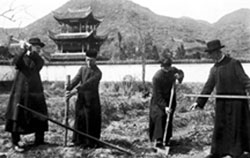 Fr. Fraser (R) at the start of another building project, a church in Lungchuan, with (L-R) his brother, Fr. William Fraser, and Frs. Paul Kam and Ramon Serra, China, 1928.
Fr. Fraser (R) at the start of another building project, a church in Lungchuan, with (L-R) his brother, Fr. William Fraser, and Frs. Paul Kam and Ramon Serra, China, 1928.
I left Toronto on September 9, 1932, with five of our seminarians who had been accepted in Brignole Sale, Genoa, my alma mater...I reckoned that our men would have a broader outlook and not be so parochial minded if they were trained abroad...At noon we boarded the Cone Grande. It was my ninth crossing of the Atlantic...
On December 14, I arrived in Kinhwa where I was to spend nine years...
In 1940, Monsignor McRae, rector of our seminary, announced that the First General Chapter of our Society would be held at Scarboro Bluffs, Canada, in 1941, and invited me to attend. He sent each of us a copy of our constitutions, with blank sheets at every page for any amendments to the constitutions or suggestions we wished to make. They would be considered at the Chapter.
I decided, instead of making suggestions, to re-write the constitutions in their entirety. I borrowed the constitutions of the Milan Foreign Mission from a priest in Honan...I translated them into English, making changes suitable for our institution, and sent them to Monsignor McRae. He was delighted. It made less work for him and for everybody. These constitute the bulk of our present constitutions, approved by the Holy See in 1941...
When the General Chapter came to an end in June I made a hasty visit to 14 directors of the Society for the Propagation of the Faith in the Eastern States, and received substantial aid for my mission. I had been absent from Kinhwa for five months and was anxious to get back before the threatening war between the United States and Japan broke out...
I left San Francisco on the President Harrison on October 17, expecting to be in Shanghai in a fortnight. It was five years before I arrived!
(World War II intervened and Monsignor Fraser spent four and a half years in the Philippines, which was under Japanese occupation. He returned to Canada in 1945 when the war ended. In 1946 he finally returned to China, but was there for only three years before the takeover of China by the Communists and the eventual expulsion of all Scarboro missionaries.)
...I left Toronto on April 10, 1946 (to return to China)...At Kinhwa I found my church in a sad state. The steeple had been demolished; the military having feared it would be a target for bombers. The altars and pews were gone and the whole building was in need of repairs...
Grey Nuns of the Immaculate Conception came to open a dispensary and teach catechism. The Sisters did good work, especially among wounded soldiers, thousands of whom passed through Kinhwa, fleeing from the advancing Communists. The Sisters converted quite a number of them...
In 1949 my Scarboro priest companions and I were recalled to Canada to attend the Second General Chapter of the Scarboro Foreign Mission Society...We arrived in Toronto, June 2, 1949. The Second General Chapter, in which Very Rev. Thomas McQuaid was elected Superior General, lasted from August 22 to September 14.
As it was impossible to return to China, I now had to make an important decision, whether to remain in Canada campaigning, or to go to Santo Domingo (Dominican Republic) or to Japan. I chose the latter. Bishop Yamaguchi sent me a cordial invitation to go to Nagasaki. He wished me to rebuild a large church, Queen of Martyrs, destroyed by the atomic bomb in 1945...I left San Francisco, May 28, 1950, and arrived in Tokyo on June 20, this being my 12th crossing of the Pacific...
On July 14, 1951, I celebrated the 50th anniversary of my ordination. I had much to be thankful for. I have always enjoyed good health and have never been too sick to say Mass and recite the Divine Office...
I have been requested to put in writing my experiences in China. It has always been repugnant to me to speak of myself but in consideration of the many requests, I can no longer refuse. Obedience, therefore, is my only excuse for writing these memoirs. All I ask from the readers of these memoirs, if they have had any pleasure in reading them, is an occasional prayer for the conversion of China and Japan."
Monsignor John Mary Fraser, founder of Scarboro Missions, completed this autobiography on February 23, 1955, in Fukuoka City, Japan. He died in Osaka, Japan, on September 3, 1962, in Our Lady of Angels parish, the last of 39 churches he built during his 61 years of priesthood.
MONSIGNOR JOHN MARY FRASER
Founder of Scarboro Missions
ZEAL FOR MISSION:
- A visionary with persevering zeal, eager to commit his whole life for Christ in mission overseas.
- Responded boldly where he saw the greatest urgency in mission.
SOLIDARITY WITH THE POOR:
- Deeply moved to action by the poverty of the people.
- Loved the people among whom he lived and worked.
BUILDER OF THE LOCAL CHURCH:
- Prophetic in his efforts to change the model of Church in China from foreign control to one run by Chinese bishops and priests.
- Vigorous promoter of priestly and religious vocations to the Church in the countries where he worked; trained many catechist leaders.
- Built many churches and convents to enable the local Church to develop.
LIVED SIMPLY AND PRAYERFULLY:
- Lived simply, austerely, with few personal possessions.
- Developed a deep, prayerful union with Christ, always conscious of the needs of others, quietly faithful to God, urging the same for all Scarboro missionaries.
RECRUITER, COMMUNICATOR, PROMOTER:
- Tirelessly sought to engage others in mission work, in Canada and elsewhere.
- Challenged Church authorities at home and abroad to develop a missionary outlook beyond their dioceses and respective countries.
- Preached, wrote letters, edited China magazine, and canvassed bishops, priests and seminaries to educate, inspire, and recruit people for mission.
(The above was prepared by Fr. Mike Traher, S.F.M.)
Return to Table of Contents
Print Article
